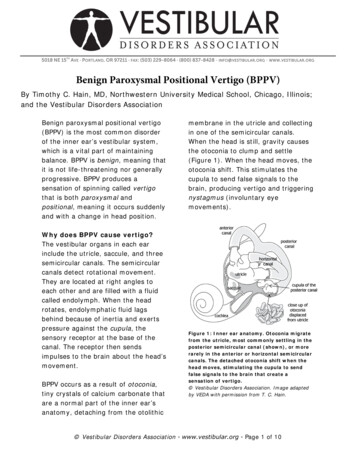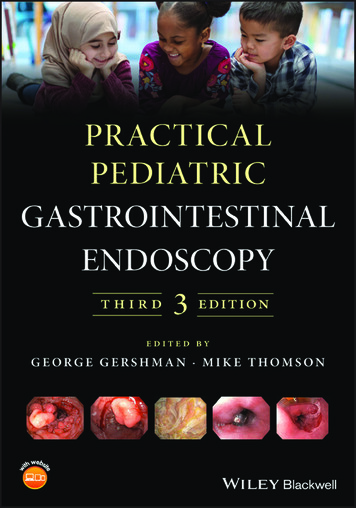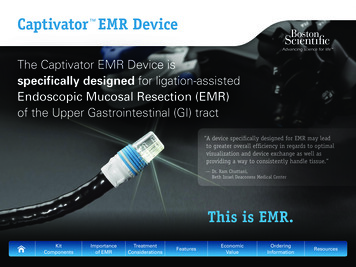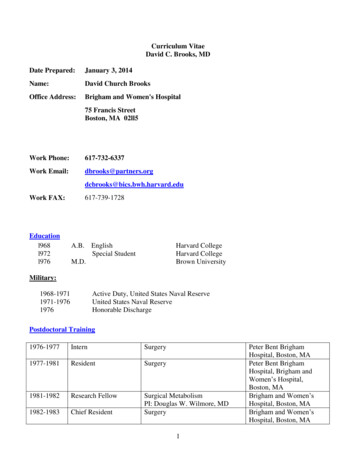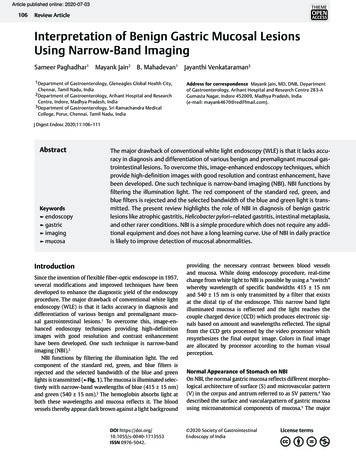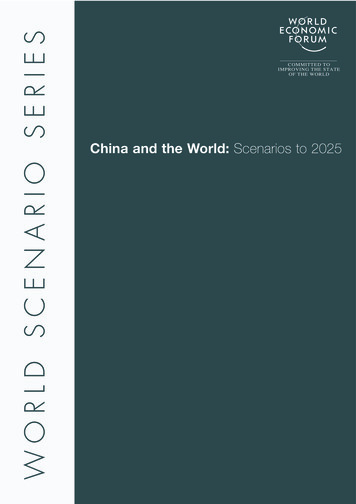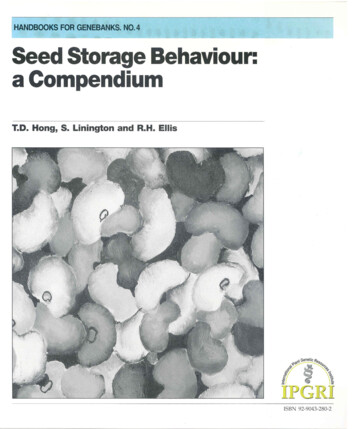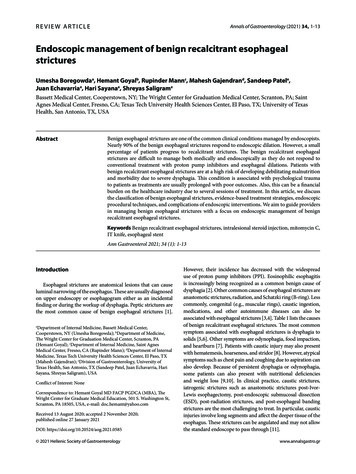
Transcription
REVIEW ARTICLEAnnals of Gastroenterology (2021) 34, 1-13Endoscopic management of benign recalcitrant esophagealstricturesUmesha Boregowdaa, Hemant Goyalb, Rupinder Mannc, Mahesh Gajendrand, Sandeep Patele,Juan Echavarriae, Hari Sayanae, Shreyas SaligrameBassett Medical Center, Cooperstown, NY; The Wright Center for Graduation Medical Center, Scranton, PA; SaintAgnes Medical Center, Fresno, CA; Texas Tech University Health Sciences Center, El Paso, TX; University of TexasHealth, San Antonio, TX, USAAbstractBenign esophageal strictures are one of the common clinical conditions managed by endoscopists.Nearly 90% of the benign esophageal strictures respond to endoscopic dilation. However, a smallpercentage of patients progress to recalcitrant strictures. The benign recalcitrant esophagealstrictures are difficult to manage both medically and endoscopically as they do not respond toconventional treatment with proton pump inhibitors and esophageal dilations. Patients withbenign recalcitrant esophageal strictures are at a high risk of developing debilitating malnutritionand morbidity due to severe dysphagia. This condition is associated with psychological traumato patients as treatments are usually prolonged with poor outcomes. Also, this can be a financialburden on the healthcare industry due to several sessions of treatment. In this article, we discussthe classification of benign esophageal strictures, evidence-based treatment strategies, endoscopicprocedural techniques, and complications of endoscopic interventions. We aim to guide providersin managing benign esophageal strictures with a focus on endoscopic management of benignrecalcitrant esophageal strictures.Keywords Benign recalcitrant esophageal strictures, intralesional steroid injection, mitomycin C,IT knife, esophageal stentAnn Gastroenterol 2021; 34 (1): 1-13DOI: https://doi.org/10.20524/aog.2021.0585However, their incidence has decreased with the widespreaduse of proton pump inhibitors (PPI). Eosinophilic esophagitisis increasingly being recognized as a common benign cause ofdysphagia [2]. Other common causes of esophageal strictures areanastomotic strictures, radiation, and Schatzki ring (B-ring). Lesscommonly, congenital (e.g., muscular rings), caustic ingestion,medications, and other autoimmune diseases can also beassociated with esophageal strictures [3,4]. Table 1 lists the causesof benign recalcitrant esophageal strictures. The most commonsymptom associated with esophageal strictures is dysphagia tosolids [5,6]. Other symptoms are odynophagia, food impaction,and heartburn [7]. Patients with caustic injury may also presentwith hematemesis, hoarseness, and stridor [8]. However, atypicalsymptoms such as chest pain and coughing due to aspiration canalso develop. Because of persistent dysphagia or odynophagia,some patients can also present with nutritional deficienciesand weight loss [9,10]. In clinical practice, caustic strictures,iatrogenic strictures such as anastomotic strictures post-IvorLewis esophagectomy, post-endoscopic submucosal dissection(ESD), post-radiation strictures, and post-esophageal bandingstrictures are the most challenging to treat. In particular, causticinjuries involve long segments and affect the deeper tissue of theesophagus. These strictures can be angulated and may not allowthe standard endoscope to pass through [11]. 2021 Hellenic Society of Gastroenterology www.annalsgastro.grIntroductionEsophageal strictures are anatomical lesions that can causeluminal narrowing of the esophagus. These are usually diagnosedon upper endoscopy or esophagogram either as an incidentalfinding or during the workup of dysphagia. Peptic strictures arethe most common cause of benign esophageal strictures [1].Department of Internal Medicine, Bassett Medical Center,Cooperstown, NY (Umesha Boregowda); bDepartment of Medicine,The Wright Center for Graduation Medical Center, Scranton, PA(Hemant Goyal); cDepartment of Internal Medicine, Saint AgnesMedical Center, Fresno, CA (Rupinder Mann); dDepartment of InternalMedicine, Texas Tech University Health Sciences Center, El Paso, TX(Mahesh Gajendran); eDivision of Gastroenterology, University ofTexas Health, San Antonio, TX (Sandeep Patel, Juan Echavarria, HariSayana, Shreyas Saligram), USAaConflict of Interest: NoneCorrespondence to: Hemant Goyal MD FACP PGDCA (MBA), TheWright Center for Graduate Medical Education, 501 S. Washington St,Scranton, PA 18505, USA, e-mail: doc.hemant@yahoo.comReceived 13 August 2020; accepted 2 November 2020;published online 27 January 2021
2 U. Boregowda et alIn this review, we discuss the classification of benignesophageal strictures, the available endoscopic treatmentoptions and techniques of endoscopic interventions withtheir potential complications, and the future directions in themanagement of benign recalcitrant esophageal strictures.The benign recalcitrant esophageal strictures can be furtherclassified as shown below.Benign refractory esophageal stricturesBenign esophageal strictures are classified into simple andcomplex strictures [12,13].Failure to achieve an esophageal luminal diameter of 14 mm after 5 sessions of endoscopic dilation with 2-weekintervals are considered refractory strictures [2]. This is mainlydue to underlying fibrosis, and visible inflammation is absentby endoscopy. Fig. 1 illustrates an example of recalcitrantbenign esophageal stricture.Simple stricturesBenign recurrent esophageal stricturesAn esophageal stricture is considered as simple if it is focal,short ( 2 cm in length), and a lumen diameter of 12 mm.An adult endoscope which has a diameter of 10 mm cantraverse simple strictures with ease, and they are amenableto endoscopic dilation [2]. On average, simple stricturesrequire 1-3 dilations to relieve symptoms of dysphagia [12].The most common causes of simple strictures are pepticstrictures, Schatzki ring, esophageal web, and eosinophilicesophagitis [13].Inability to maintain a luminal diameter of 14 mm formore than 4 weeks after achieving initial dilation to 14 mmis considered as a recurrent benign esophageal stricture [15].This is also due to underlying fibrosis, and there is no visibleinflammation on endoscopy.ClassificationComplex stricturesComplex esophageal strictures are usually longer than2 cm, irregular, tortuous, or angulated with a severely narrowedlumen. The luminal diameter is 12 mm [2]. They might notallow a standard size endoscope to traverse the stricture [14].Complex strictures are difficult to manage due to a morefrequent recurrence compared to simple strictures. Commoncauses of complex strictures are corrosive injury, anastomoticstrictures, radiation-induced strictures, and strictures due tothe complication from ESD [13].Both simple and complex strictures can progress to benignrecalcitrant esophageal strictures despite their treatment.Predictors of recurrenceRecurrent symptoms of dysphagia despite dilation canbe as high as 40% [2,16]. This means that recurrence rates ofstrictures are high despite dilation and medical management.Prior literature suggests that the persistence of heartburn afterdilation despite the use of PPI predicts recurrence amongpeptic strictures [17]. In a case-control study, 87 consecutivepatients with benign esophageal strictures undergoing initialdilation were followed for 1 year. Multivariate analysis atthe end of the study showed that non-peptic strictures anda narrower diameter of the stricture predicted recurrence.Uncontrolled acid reflux, non-peptic strictures such asanastomotic strictures, strictures due to surgery, corrosiveinjury, undiagnosed eosinophilic esophagitis, and radiationTable 1 Common causes of benign recalcitrant esophageal stricturesCommon causes of benign recalcitrant esophageal stricturesPeptic stricturesSchatzki ringRadiation therapyPost-anastomotic stricturesEosinophilic esophagitisSclerotherapyCaustic injuryPhotodynamic therapyIatrogenic (e.g., post-endoscopic mucosal resection, post-endoscopicsubmucosal, post-esophageal varices ligation and sclerosis)Annals of Gastroenterology 34 Figure 1 Benign recalcitrant esophageal stricture
Endoscopic management of benign esophageal strictures 3(33%) [14] have a higher tendency for recurrence comparedto peptic strictures. Severe esophageal stenosis (luminaldiameter 9 mm), use of fluoroscopy during dilation, andfemale sex also predicted the risk of recurrence in radiationstrictures [14,17].Treatment strategiesMedical management of benign esophageal stricturesReflux esophagitis due to gastric acid causes collagen andfibrous tissue deposition leading to stricture formation [18].Persistent acid exposure to the esophagus will result in fibrosis,which in turn can lead to a benign recalcitrant esophageal stricture.Therefore, protection from injury due to acid reflux can play a rolein the healing of reflux esophagitis and strictures. Although thereis no direct evidence, the literature suggests that the increasing useof PPI from the year 1994 to 2000 has led to a decreased incidenceof esophageal strictures, indirectly suggesting that PPI can play asignificant role in the treatment of benign esophageal strictures.The incidence of benign esophageal strictures was 1.1 per 10,000before PPI use, which decreased to 0.6 (95% confidence interval[CI] 0.3-1.1) later [19].Protection of the esophageal mucosa from acid refluxcan be achieved through gastric acid suppression andalso by providing a mechanical barrier. Commonly usedacid-suppressing agents are PPI and histamine-2 receptorantagonists (H2RA) (e.g., famotidine). Literature suggestsPPIs are superior to H2RA in gastric acid suppression. Arandomized controlled trial (RCT) (n 366) showed thatpatients who received omeprazole after endoscopic dilationneeded fewer re-dilations compared to those who receivedranitidine (30% vs. 46%; P 0.01) [20]. Sucralfate can providea mechanical barrier by coating the esophageal mucosa atthe site of injury, preventing further injury. A prospectivestudy involving 15 patients with corrosive injury evaluatedthe effectiveness of sucralfate for the prevention of recurrentstrictures and consequently the reduction in the need forrepeat dilations. At the end of 3 and 6 months, patients whoreceived intense sucralfate therapy had a significantly lowerrecurrence of a stricture compared to those who did not (1 of8 vs. 6 of 7; P 0.01) [21].In our practice, all patients who undergo endoscopicdilation receive a high-dose PPI (e.g., omeprazole 40 mg b.i.d.)along with sucralfate to help the healing of the esophageal ulcerand reduce acid injury during the course of dilation of benignsimple or complex esophageal strictures thereby minimizing orpreventing benign recalcitrant esophageal strictures.Endoscopic management of benign esophagealstricturesNearly 80-90% of the benign esophageal strictures can betreated with 5 sessions of balloon dilation [22,23].Endoscopic dilationEsophageal dilation is the first step in the treatment ofsymptomatic benign esophageal strictures. Dilation can bedone using endoscopic balloon dilators or Savary-Gilliard (SG)dilator (Cook Medical, USA). SG dilator produces longitudinalshear force and a radial force together; on the other hand,balloon dilators produce only radial force [24]. The SG dilatormay dilate “non-visible” stenoses along the entire length of theesophagus, especially with the small-caliber esophagus, as theyare frequently seen in cases of eosinophilic esophagitis [25].The size of the SG dilator is fixed and known. Therefore,bougie dilation can also provide a good estimate of the luminaldiameter at the stricture once the procedure is completed. Theballoon dilator has the advantage of direct visualization of thestricture and the ability to control the radial force applied duringthe dilation. Visualization of the stenosis through the balloongives the theoretical advantage of visualizing a significant tearearly on, therefore allowing to deflate the balloon early on topotentially avoid a perforation. Both SG and balloon dilators areequally effective and safe in achieving adequate dilation [26]. Theabsolute contraindication for dilation is the presence of acuteor incompletely healed esophageal perforation. Documentedrelative contraindications are uncontrolled coagulopathy or theuse of anticoagulants and the inability to safely sedate patientsdue to cardiopulmonary or anatomic abnormalities [27].Fig. 2 shows before and after pictures of a benign recalcitrantesophageal stricture treated with balloon dilation.Techniques and complications of endoscopic balloondilationVisualization of the stricture and selection of appropriatescope size is important to achieve better results. Priorknowledge about the duration, length, and luminal size of thestricture and its etiology can assist in making these decisions.It is recommended to use a balloon size 1-2 mm larger thanthe size of the stricture and to limit the target dilation to nomore than 3 dilators of sequential size once moderate or greaterresistance is noted (“rule of 3”). However, such “rules” are onlybased on an expert’s opinion [28]. Recent studies have shownthat not adhering to the “rule of 3” did not increase the risk ofperforation or other adverse events in the benign esophagealstrictures [29,30]. It is our institution’s experience that moreaggressive and longer treatments may lead to the best long-termresults, although they may not be cost-effective. There is nodifference in clinical outcomes between wire-guided bougie andthrough-the-scope balloon dilators. The optimal duration ofballoon inflation is not known. However, inflation for 30-60 secis recommended [12,31]. A pressure gauge helps monitor thepressure during insufflation [31]. The balloon is deflated beforerepeating the dilation. Endoscopic inspection is recommendedafter each balloon size insufflation to look at the stricture site forsigns of mucosal tear. If there is minimal or no dilatation, theballoon can be insufflated to the next size. Endoscopists shouldalso continue to communicate with the endoscopy assistantAnnals of Gastroenterology 34
4 U. Boregowda et alABCFigure 2 Balloon dilation of a benign recalcitrant esophageal stricture (A) Pre-dilation, (B) Balloon dilation, and (C) Post-dilation mucosal tearinsufflating the balloon for the development of resistance,which could give a fair idea of radial force on the esophagealwall. If a significant esophageal mucosal tear is noted, nofurther dilation should be attempted. When the lumen isdilated to 16 mm, anastomotic strictures usually have longersymptom-free interval and can prolong the intervals betweenthe dilations [30]. Most patients can tolerate a normal diet whenthe luminal diameter is 13-15 mm [27,32]. Practice guidelinesfrom the United Kingdom recommend dilation of luminal sizeto 15 mm for sustained symptomatic improvement [10].Techniques and complications of SG dilationSG dilation includes passage of a SG dilator of a particulardiameter based on the prior knowledge of stricture length andluminal size. SG dilators are available in varying sizes from 18-60Fr (6-20 mm). SG dilators have a guidewire over which the dilatoris inserted. The endoscopist passes these dilators and relies onthe tactile perception to determine the effectiveness and need forrepetition. Typically, multiple passes are needed to achieve therequired dilation. Intermittent re-inspection is similarly helpfulwhen SG dilator is being used to look at the stricture site forsigns of mucosal tear. The most common complications due toSG dilation are hemorrhage, perforation, and are more commonwith the blind passage of the non-guidewire dilators [22].Endoscopic dilation with the aid of fluoroscopyIf the adult esophagogastroduodenoscopy (EGD) scopeor pediatric EGD scope can traverse the stricture to inserta guidewire, dilation can be performed without the aid offluoroscopy. However, in complex strictures, it may not alwaysbe possible to traverse the stricture with the endoscope to passthe guidewire. Contrast dye has to be injected to delineatethe length and diameter of the stricture. A guidewire has tobe passed carefully across the stricture, and either a balloondilator or SG dilator can be passed over the guidewire with theaid of fluoroscopy to dilate it to the desired size.SG vs. endoscopic balloon dilationPrevious studies have shown that both balloon and SGdilations are comparable in relieving dysphagia symptoms,Annals of Gastroenterology 34 recurrence, and complications. A meta-analysis of 5 RCTscomparing SG vs. balloon dilation of benign esophagealstrictures showed no significant difference in symptomaticrelief (risk difference 0.00, 95%CI 0.08 to 0.08; P 0.92), rate ofrecurrence (risk difference 0.03, 95%CI 0.05 to 0.10; P 0.46),bleeding (risk difference 0.02, 95%CI 0.06 to 0.02; P 0.38),or perforation (risk difference 0.01, 95%CI 0.03 to 0.02;P 0.66). However, patients who underwent balloon dilationhad a significantly lower post-procedure pain incidencecompared to SG dilation (risk difference -0.5, 95%CI -0.47 to-0.07; P 0.007) [33].Endoscopic managementesophageal stricturesofbenignrecalcitrantBenign recalcitrant stricture remediation can be complexand risky. There are various advanced endoscopic techniquesavailable to treat these strictures. Our approach is to treatthese strictures with low-risk minimally invasive proceduresand then advance to high-risk minimally invasive proceduresin nonresponsive patients. The goal of treatment is to relievedysphagia symptoms from mechanical stenosis and preventrecurrence of stricture, thereby providing a durable effect [27].Endoscopic dilation is the first choice of treatment for allsymptomatic benign esophageal strictures. If symptoms persistbeyond 5 sessions of endoscopic dilation, the following are theavailable advanced techniques for the management of benignrecalcitrant esophageal strictures:1. Endoscopic dilation with intralesional steroid injection2. Endoscopic dilation with intralesional mitomycin Cinjection3. Endoscopic incisional therapy or stricturoplasty4. Esophageal stent placement5. Self-dilation6. Surgical interventionEndoscopic dilation and steroid injectionTopical injection of steroids (e.g., triamcinolone acetate) hasbeen evaluated in the treatment of benign recalcitrant stricturesthat do not respond to repeat endoscopic dilations alone. Itis postulated that, due to their anti-inflammatory propertiesand ability to interfere with collagen synthesis and fibrosis,
Endoscopic management of benign esophageal strictures 5steroid injections can reduce the inflammation and fibrosis ofthe strictures after endoscopic dilation [34]. A recent reviewmentioned a significant variation in the doses and concentrationsused in the literature, ranging between 20 mg, 32 mg, and 40 mgper patient. One trial injected 5 mg of triamcinolone every10 mm into the stricture [35]. Our preference is endoscopicdilation following the submucosal injection of triamcinoloneacetonide injections. A vial of 1 mL (40 mg/mL) triamcinoloneshould be diluted 1:1 in normal saline (1 mL). An aliquotof 0.5 mL is injected into each quadrant of the stricture. Forlonger strictures, this could be repeated every 2 cm. Althoughprevious studies have been inconclusive, recent studies suggesta beneficial effect of steroid injection [36]. No more than 3sessions of endoscopic dilation with steroid injections shouldbe attempted since it is less likely to be beneficial [16]. If thereis still no improvement in dysphagia symptoms, alternativetreatment options should be considered.In a recent RCT, 65 patients with anastomotic strictures wererandomized into the study group (endoscopic dilation steroidinjection; n 33) and placebo group (endoscopic dilation saline injection; n 32). After 6 months of follow up, the mediannumber of dilations required to resolve the strictures in thestudy group was significantly lower than in the placebo group(2 vs. 4 dilations, P 0.001). Moreover, among the study group,36% remained recurrence-free, whereas only 16% of patients inthe placebo group remained recurrence-free [37].A meta-analysis of 3 RCTs of 144 patients (steroid andplacebo groups, 72 patients in each) in benign anastomoticesophageal strictures showed that the mean number ofdilations required for dysphagia relief was significantly lowerin the steroid group (mean weighted difference of –1.62,95%CI –2.73 to –0.50; P 0.004) than in the control group.The steroid group also had a higher odds of being dysphagiafree at 6 months after initial dilation compared to the placebogroup (2.36, 95%CI 0.94-5.91; P 0.07) [36]. A combination ofdilation and steroid injection has shown a clinical benefit inreducing the need for repeat interventions and increasing theinterval between endoscopic dilation from the above studies.However, larger multicenter RCTs are needed to prove thebenefit of intralesional steroid injection in benign recalcitrantesophageal strictures.Endoscopic dilation and mitomycin C injectionMitomycin C is a chemotherapeutic agent used in thetreatment of upper gastrointestinal cancers such as esophagealcarcinoma, anal, breast, and bladder cancer. Due to its abilityto inhibit fibroblasts and collagen formation, intralesionalmitomycin C injection is considered as an alternative to topicalsteroids in the treatment of benign recalcitrant esophagealstrictures [38]. Previous studies have used a variableconcentration of mitomycin C (0.1-1 mg/mL) and differentmethods of the drug application for the treatment of benignrecalcitrant esophageal strictures [39-41]. Cotton pledgets orsterile gauzes soaked in mitomycin C were rubbed against thearea of the stricture for 3 min after dilation, or it was injecteddirectly into the stricture after dilation by these prior studies.In our practice, mitomycin C (0.4 mg/mL) is diluted in 1 mL ofsaline and then divided into aliquots of 0.5 mL. One aliquot isinjected into 4 quadrants of the narrowest part of the strictureafter the dilation [22,42]. Serious adverse effects can occurwith higher concentrations of topical therapy or endoscopicinjection of mitomycin C. The most common adverse eventsinclude intense pain, necrosis, and ulceration [42-45].Previously published studies included a smaller numberof patients, and the majority of them were in the pediatricpopulation. The mitomycin C injection is observed to beparticularly effective in corrosive strictures [46].In a prospective pilot study, 9 patients were initially treated withendoscopic dilation alone for 8 months, followed by endoscopicdilation with mitomycin C injection, and followed up for 10months. Following mitomycin C injection, the need for repeatdilation decreased from 1.5 dilations per month to 0.39 dilationsper month. There was also a non-significant improvement inmean dysphagia score as well (from 3.2 to 2.6) [41].In another prospective study, including 13 patients withrecurrent pharyngoesophageal strictures after head-and-neckcancer treatment, the mitomycin C injection was observed to causeincreased adverse events, including ulcers and intense neck pain,and therefore the trial was aborted prematurely [42]. Althoughthe evidence in the pediatric population is promising, large RCTsare required before mitomycin C injection becomes a standard fortreatment in adults with a benign recalcitrant esophageal stricture.Incisional therapy or stricturoplastyIncisional therapy is another promising modality inthe treatment of benign recalcitrant esophageal strictures.Incisional therapy can be performed using a standard needleknife or an insulated tip electrosurgical knife (IT knife). Patientswith short and elevated strictures made of fibrous scar tissuessuch as Schatzki ring and anastomotic strictures have favorableoutcomes with this procedure. A standard needle-knife is anaked diathermy wire at the end of the device. The incisionis made with electrocautery using electrosurgical generators.However, this technique can potentially increase the risk ofesophageal perforation. To minimize the risk of perforation,an insulated ceramic tip is added that allows cutting only alongthe side. Table 2 shows studies that evaluated incisional therapyfor anastomotic strictures. As described in Table 2, a total of 12studies with 179 patients were treated with incisional therapy.The immediate clinical success after treatment ranged from81-100%, and the number of patients who were symptom-freeranged from 44-93% after a mean follow up of 24.7 months. Thecomplication rate was reported to be 3.5-18% in these studies.Techniques and complicationsIn this technique, 4-8 radial incisions are made inthe stricture area using an electrosurgical needle knife.Annals of Gastroenterology 34
6 U. Boregowda et alTable 2 Studies that evaluated incisional therapy for anastomotic stricturesAuthor andYearTechniqueType ofstricturePatients(n)Follow-upduration (months)Clinical success Immediateand at the end of follow upSchubert2003 [68]Tip of polypectomysnare with APCSimmons2006 [69]Complications(%)Treatmentnaïve1523100% and 93%NoneElectrocautery incisionRefractory91488.8% and 44.4%NoneHordijk2006 [49]Electrocautery incisionRefractory2012100% and 60%NoneHordijk2009 [70]Electrocautery incisionTreatmentnaïveEIT(n 31)SB (n 31)6(80.6% vs. 67.7%)Treatment failure- EIT arm- 1; SB arm - 5NoneLee2009 [50]Insulated tip knife,endoscopic hood/capTreatmentnaïve2424100% and 87.5%NoneMuto2012 [71]Electrocautery incisionRefractoryEIT – 32EBD - 22EIT – 12EBD - 17.2EIT 81.3% and 62%EBD 93.8% and 19.8%3.5%Tan2016 [72]Electrocautery incisionRefractoryanastomotic1324100% and 60%NAPross1998 [73]Electrocautery incisionAnastomotic5NA100% and NANoneHagiwara1999 [74]Electrocautery incisionRefractoryanastomotic6NA83.33% and NANABrandimarte2002 [75]Electrocautery incisionRefractoryanastomotic624100% and 36%NoneDisario2002 [76]Electrocautery incisionSchatzki ring1172100% and 36%18%Burdick1993 [77]Electrocautery incisionSchatzki ring736100% and 85.7%NoneEIT, endoscopic incisional therapy; SB, Savary-Gilliard ; EBD, endoscopic balloon dilatation; NA, not applicable; APC, argon plasma coagulationIt is recommended that the depth of the incision shouldnot exceed the continuity of the esophageal lumen. Theremaining fibrous scar tissue between the incisions canbe excised. Patients with short elevated fibrous strictures(1-2 cm) are ideal patients for this procedure. A combinationof incisional therapy followed by balloon dilation duringthe same session has been evaluated in small case reportsand case series [47,48]. However, the data is inadequateto make recommendations on whether this techniqueis effective and safe. Fig. 3 shows a benign recalcitrantesophageal stricture treated with needle knife stricturoplasty,and Fig. 4 shows pre-treatment and post-treatment views ofthe benign recalcitrant esophageal stricture with IT knifestricturoplasty.In a prospective study, 20 patients with anastomoticesophageal strictures refractory to balloon dilation weretreated with electrocautery incisional therapy. Twelve patientswho had short segment strictures remained dysphagia-free atthe end of 1 year, and the remaining 8 patients who had longsegment strictures required at least 3 sessions of incisionaltherapy [49]. There were no perforations.In another retrospective study, incisional therapy was usedas a treatment in 24 patients with benign recalcitrant esophagealstrictures. With just 1 session of incisional therapy, 87.5% ofAnnals of Gastroenterology 34 ABFigure 3 Benign recalcitrant esophageal stricture before (A) and after(B) standard needle knife stricturoplastyABFigure 4 Pre-treatment (A) and post-treatment (B) appearance of thebenign recalcitrant esophageal stricture with IT knife stricturoplastythe patients remained free of dysphagia at the end of 2 years.It was also observed that recurrence of the stricture was more
Endoscopic management of benign esophageal strictures 7common among the patients who had long-segment strictures(66%) compared to short-segment strictures (4%) [50].Stent placementEsophageal stents can be placed as a treatment for themanagement of benign recalcitrant esophageal strictures.Various types of stents have been used in the treatment of benignrecalcitrant esophageal strictures, including self-expandingplastic stent (SEPS), fully-covered self-expanding metal stents(SEMS), partially-covered self-expanding metal stents, lumenapposing metal stents (LAMS), and biodegradable stents. Theprior studies on outcomes of placement of fully-covered SEMS,SEPS, and biodegradable stents are shown in Tables 3-5. Metalstents are used more commonly than plastic stents for thetreatment of benign recalcitrant esophageal strictures as plasticstents can cause high rates of migration (62%), endoscopicreintervention (21%), and low long-term relief of dysphagia(30%) [51]. Therefore, our article will focus on the metal stents,first discussing fully-covered SEMS and LAMS, as these are themost commonly used in practice.Techniques and complicationsFirst, the guidewire is passed through the stricture, and thendilation of the stricture can be performed by either balloon or SGdilator if required to pass the 7-Fr stent delivery apparatus. Radioopaque markers (for example, paper pins) are placed at distal andproximal edges of the stricture. Under fluoroscopic guidance, afully-covered SEMS is deployed, and adequate placement is verifiedwith endoscopy. Alternatively, the fully-covered SEMS can also beplaced under direct visualization of endoscopy without the aid offluoroscopy. All patients receive PPI after the stent placement ifit results in a permanently open gastroesophageal junctionleading to the risk of reflux and aspiration. However, this maynot be necessary if the stent does not bridge the gastroesophagealjunction. The European Society of Gastrointestinal Endoscopy(ESGE) recommends fully-covered SEMS should be left in placefor a maximum of 12 weeks to minimize the risk of hyperplastictissue and stent embedment [38]. These stents c
Agnes Medical Center, Fresno, CA; Texas Tech University Health Sciences Center, El Paso, TX; University of Texas Health, San Antonio, TX, USA . Hemant Goyal MD FACP PGDCA (MBA), The . Scranton, PA 18505, USA, e-mail: doc.hemant@yahoo.com Received 13 August 2020; accepted 2 November 2020; published online 27 January 2021 DOI: https://doi.org .

